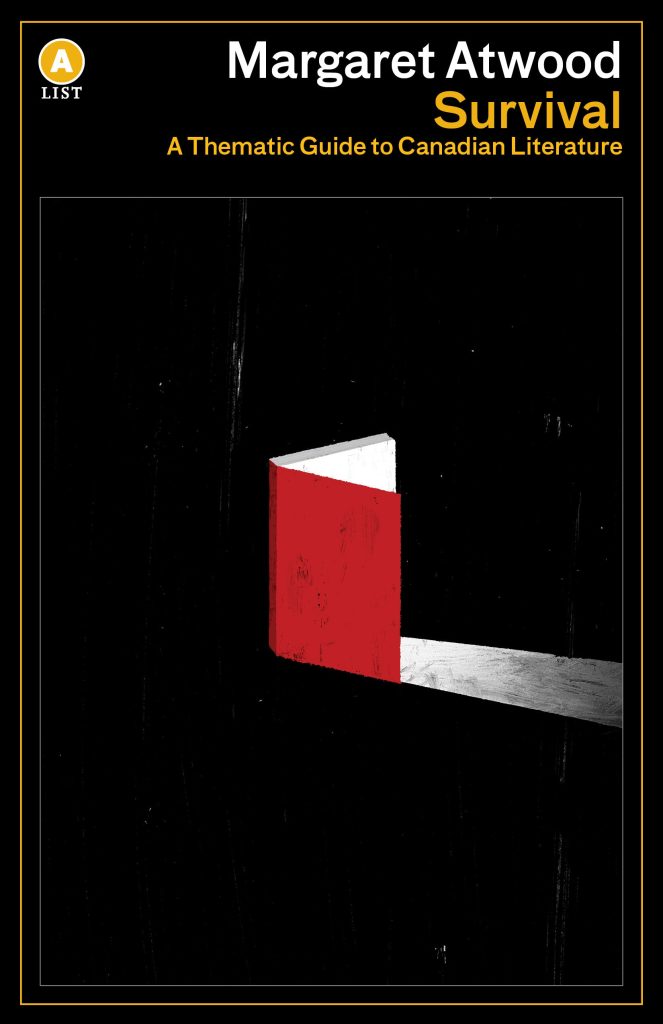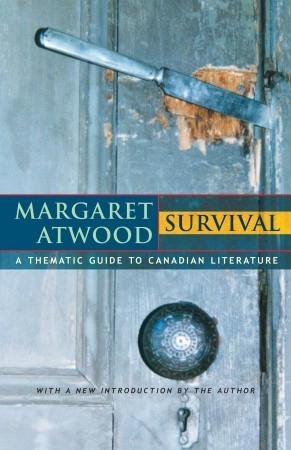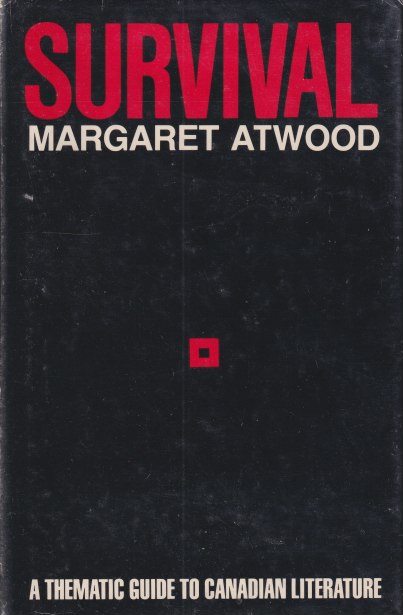Margaret Atwood’s Survival- A Milestone
Canadian literature – what is that? Is it the imagination of a few dreamers or does it really have some real existence? Even if it is taken for granted that there is something called Canadian literature in reality, that there is, in fact, a quantum of literature and that it is mostly written in English , then is that so called Canadian literature is in reality a shadow or a poor imitation of the English literature on both sides of the Atlantic ocean, i.e. England and the United States of America or it has , by and large, some inherent value on the basis of which it deserves to be recognized as literature that authorizes it to play its tune in the orchestra known as English literature ?
No literature has, in reality, a rootless and aerial existence. On the other hand, a literature is written by people of a given area, where that literature is born and nurtured. The area has a definite geographical contour, has a peculiar life style of a known group of people, has a marked essence of life, has a social panorama and literature of that area reflects all these idiosyncrasies.

As literature is the collective consciousness of the society at large, and hence to understand the nuances of a particular literature, it is essential to know the topographical pattern of the area, economic conditions and social stratification. It may sound silly, but it is a reality, that not to speak of the people of other countries, even Canadians themselves, by and large, were blissfully ignorant about Canadian literature, and worst still. They did not know that they did not know.
In this background Margaret Atwood’s book, Survival, was published. This book, literally, threw a stone into the calm water and sent shock waves all around. At first we are to understand the context of this particular book before we can venture to appreciate it. Why this one single book created so much interest among the common readers, drew the attention of so many literary scholars whose age old ideas got a jolt as this one book of moderate size overnight revolutionized their perception.

Survival is not only a book about Canadian literature, it is a milestone. It was published in 1972 and the immediate popularity it gained was unbelievable, not only in the context of Canadian literature but also in the context of literature all over the globe. It will help us to evaluate this book, if we take into consideration what was the common perception of Canadians about their own literature, five decades ago, when the book was published. We know that most of the Canadians were blissfully ignorant about their own literature.
Naturally, the book, Survival, created a commotion in the firmament of Canadian literature. Many critics initially thought that the subject matter of Survival either had no real existence or had no genuine claim to be taken seriously. Those critics who did not like the book, not only criticized the book, they did not spare the author either. They pictured the author, Margaret Atwood, as a disguised socialist while others condemned her as a lackey of capitalism. Anansi, that published the book, was founded only six years back. The prime motive of Denis Lee and David Godfred, in jointly establishing this publication house was to create an outlet for the publication of books written by rookie Canadian authors. We also know that the limited number of books of Canadian literature in those days were collection of poems or short stories. Novels were still a distant cry in Canadian literature.

The EXPO, held in 1967 in the Canadian city of Montreal, was a pioneer in introducing Canada to the outside world. It is very significant that the book, Survival, ends with the author’s pertinent question –ARE WE REALLY SURVIVING ?
We know that at the time of its publication many critics tried to undermine the importance of this book by saying that Canadian literature was a humour and did not merit serious reading. But they got a big jolt as thirty thousand copies of the book were sold immediately after its publication. It proved beyond doubt its popularity. Then those critics, who had so far mimicked Canadian literature as a big hoax, did not dare to say so after seeing its immense popularity. So, in a hushed voice, they admitted that Canadian literature did exist, but it was, at best, a second grade literature and it was nothing but a poor imitation of the English literature of England and the U.S.A. But the writer of the book, Survival, clearly demonstrated that Canadian literature had a real existence and proved with sufficient corroborating data that Canadian literature was a distinct literature and not an imitation of the English literature of England and America.
Canada is a mountain-surrounded vast country, where sweet water is abundant, climate is cold, population is thin and it is unique in diversity. The native language is mostly English, which bear direct influence of the literature of the two nations (England and America), speaking the same language. Canada’s immediate southern neighbor is the USA, a large country, which was an invader and exploiter of Canada. The other country on the eastern side of the Atlantic Ocean, the United Kingdom, is surrounded on all four sides by sea. Though it is now no more an imperial country, but not in the very remote past, this country was the supreme imperial power dominating over large part of the land mass and over majority sea routes.
Margaret Atwood’s book, Survival,’s starting point is that Canadian literature has a distinct identity and that it is not an imitation of any literature anywhere in the world. We should remember that it is better to have muddy soil under one’s feet than to have no soil at all. Canadian literature was no molehill of mud, it had already obtained the size of a mountain. Another significance of Survival is that it is just a sample and not a book to highlight the achievements of a particular author or the merits of a particular book. Moreover, this book has also some negative aspects, namely, it is no survey of a historical evolution. It is neither a biography nor an evaluation. Here the critics raise a valid question. What, then, does the book stand for? The author of the book declares in unequivocal terms that the sole purpose of the book is to introduce the people to a pattern to enable them to know what Canadian literature is and where and how it is different from other literatures written in English. We are also to bear in mind that it won’t suffice for the suggested pattern explain only a few instances , on the contrary, it should cover the whole gamut of Canadian literature , so that it can be recognized as a pattern.
Here the author, Margaret Atwood, has made a valid statement that her subject is Canadian literature, but not any literature written in Canada. The author is aware of the fact that she is to do a tight rope-walking. Because, if this book is not liked by the reading public, then this book will enhance the existing apathy towards Canadian literature. And, on the other hand, if the book is liked by the people then the Canadian will realize that there is a strong lobby, having vested interest, to make Canadian literature appear as an inferior literature. Hence the writer has made a conscious effort what is essentially Canadian of the Canadian literature. Because if any writer is asked as to what he or she writes, the answer will be straight and simple. But if the writer is asked why he or she writes, the answer will not be straight or simple, because the answer will not only be a reflection of his or her life, it will also be a reflection of the writer’s psychology and attitude towards life.
Normally, a literature has three dimensions – personal, national and universal. But strangely Canadian literature has been so portrayed as if it has only personal and universal dimension and no national dimension. As if, it is a human body having head and feet and no torso.
One advantage of reading Canadian literature is that one gets the idea as to what literature is. We know literature serves double purpose – it gives an idea of aesthetics and secondly, it places a mirror before the reader where the reader sees not only the image of the author, but also his own reflection. Naturally, if the mirror is a distorted one, it neither helps him to know himself, nor to know others. That, exactly, has been the fate of Canadian literature. The strange fact is that the authors living outside Canada, have depicted Canada, but in a disparaging manner. But by reading Canadian literature one realizes that this literature is not worthless, it is worth-reading. The readers should not only read Canadian literature, he or she should also read other literatures to acquire an balanced perspective. Otherwise the reader will not have an idea of the place of Canadian literature vis-à-vis other literatures.
On first hearing, these two words might sound silly – “WHO AM I?” and “WHERE I AM?” But for Canadians these two words are very significant and are of great relevance. When one finds himself in an alien place, then the first thing he wants to know is – WHO AM I and WHERE IS THIS PLACE. And he would try to know as to how he landed there. Canadian teachers often mislead their students by asking them to concentrate of some developments that had taken place elsewhere than to the present situation where the student is.
It is fact that, to many Canadians Canada is unknown or little known. Hence the foremost need of a Canadian is a map that will tell him about his or her exact location at a particular point of time. This will enable him to know his position vis-à-vis others. Authors can very well do this job as literature is not only a mirror, it is also a road map of his place and his mind. This is not a luxury, it is a necessity and without this it will be difficult for the man to live his life meaningfully.
Survival is the basic necessity of any person. Survival is not only important at a particular time and particular place. It is a must at every sphere of life – in prosperity, in adversity. Many writers have highlighted this point.
Every country, every literature, every culture has a symbol, which binds the people in sort of brotherhood. If the symbol for the USA is BORDER, for the UNITED KINGDOM – ISLAND, for Canada undoubtedly, it is SURVIVAL. Along with the urge to survive, there is another urge – which is about the obstacle for survival. The obstacles can be external like geographical contour, weather etc. and also internal like – survival. It is strange that this urge to live may develop a counter urge – not to live and one may fondly ask as to what is the benefit of living.
It is also a fact that since Canadian literature is of modern age, i.e. 20th century, it is mainly pessimistic. Most of the novel that will tell of unending happiness is likely to be short and monotonous. It is also true that the same novel can be positive, as well as, negative (e.g: OCEAN – Positive LIFE GIVING, Negative SHIP SINKING; TREE – Positive SYMBOL OF PROSPERITY and Negative CRUSHING PEOPLE BY FALLING ON THEM.)
Let us take for granted that Canada is a colony and it is an exploited country. We know that the people of the colonies produce wealth but that wealth is not utilized for the benefit of the people of the colony but for the benefit of the people of the colonizing country, i.e. the imperial nation. Even we accept this miserable exploitation of the colonial country, the pertinent question is – how the people of the exploited country take this reality of exploitation. The author of Survival is of the opinion that people of the exploited country look at this stark reality of exploitation from four different perspectives.
The first group refuses to accept that they are being exploited by the imperialist country. They simply deny the existence of this burning reality as often a camel hides its face in the sand and believes that there is no threatening sand storm. The votaries of this theory are not the ‘have-nots’ of the colony, they are the ‘haves’. The fact is that this group of people get some crumb thrown by the exploiters and declares that those who feel they are exploited, are really lethargic and they lack initiative and that they themselves are responsible for their wretched condition.
Then the second group. They accept that they are exploited but they blame their fate for their miserable plight and think that it is their destiny to suffer. They fight, but not against their real exploiters but against some imaginary entity, God, Fate etc.
The third group – they are most clear in their conception of reality – they accept that they are exploited and illegally deprived. They also realize that their misery is not inevitable,. It is not the will of God, but it is because of the evil design of the imperialist countries. It is very interesting that those who belong to the third group, their position is very vulnerable – both ways – they may have positive attitude and promote themselves to the fourth group, who are most sensible and pragmatic, they take the right course to change their miserable plight, they do not blame God or Fate for their wretched condition, but the real exploiters, who thrive at the cost of the exploited. But there is also the second possibility – they may demote themselves to the next lower group, i.e. the second group and remain complacent by blaming their luck for their miserable plight.
Now the fourth group – they know that they are exploited and try to identify their real exploiters, understand the real cause of their deprivation by analyzing the situation in an impartial way with the help of correct analysis, keeping in mind the economic perspective. Now they clearly know that they are exploited and they also know by whom they are exploited. They try to challenge their exploiters head on directing their wrath against the right person and never finding fault with those agencies which have no machinations to place them in their miserable plight. Here lies the sagacity of the people belonging to the fourth group. When they are angry with the powerful, they direct their anger against their real oppressor, then or later, but never against innocent and hapless people. To get rid of the problem of exploitation, they take the reasonable and the most sensible path. They never deny the existence of the problem, they never engage themselves in some impractical and imaginary effort, clever maneuvering of the oppressors to misled notwithstanding.
A book earns popularity on two counts- whether it enhances knowledge and whether it is a pleasure to read the book. Margaret Atwood’s book Survival, passes with distinction on these two counts. The author deserves kudos for her lucid style in presenting the real perspective of Canadian literature. We wonder how one single book stablished the supremacy of Canadian literature in global literary firmament. The stssyle of writing of the author is so charming that often the reader is lured to finish reading the book in one go. The lasting charm of the book is that it does not end immediately with the ending of the book, it continues to resonate in the mind of the reader. The author has enriched the book by mentioning in it the names of some outstanding books from other languages as well.
Dr. Dilip Chakraborty, born in Bangladesh, had formerly served as Principal of Goenka Girls’ College, Lachhmangarh, Rajasthan, India, and now lives in Brampton, Ontario, Canada.
